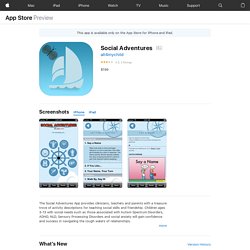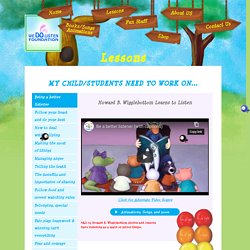

(92) Social Skills Video: Seeing Someone Else's Side. What Do You See Activity OCDRCM. (92) Social Skills Video: Compromising. Pbslearningmedia. (92) #BeGolden - "The Golden Rule" (92) Girl Scout Song 'Make New Friends' in ASL. Welcome to StoryPlace! Social Adventures on the App Store. The Social Adventures App provides clinicians, teachers and parents with a treasure trove of activity descriptions for teaching social skills and friendship.

Children ages 3-13 with social needs such as those associated with Autism Spectrum Disorders, ADHD, NLD, Sensory Processing Disorders and social anxiety will gain confidence and success in navigating the rough waters of relationships. Designed as a self-contained resource for running social cognition groups, each activity within the Social Adventures App can be used to augment other approaches. Developed and used over the course of 15 years by a team of SLP’s, OT’s and MSW’s, the Social Adventures App combines the discrete teaching of Social Catch Phrases with fundamental social skills using an engaging multi-disciplinary, multi-sensory approach to mastery. Use the Social Adventures App to teach: - Initiating interactions - Maintaining interactions. The Social Express Program – Social Express. This is a progressive school for children with Asperger Syndrome, high-functioning Autism, and language learning disabilities.

The California school helps children in grades 6 to 12. She began by using The Social Express Light, and she says, in part: The Social Express was used to enrich our topic of the month, Problem Solving. We projected the iPad screen on the board for everyone to see and interact with the lesson. That afternoon I quickly purchased the full application. Students have been extremely receptive to this 15-20 min lesson and have shown strong engagement, participation on all levels, high interest, and accurate recall in these lesson students are so excited about this application so much so that they ask to do multiple lessons during the class period! This application is so effective in the classroom!
39 Communication Games and Activities for Kids, Teens, and Students. Our world is in a communication crisis.

Kids spend astounding amounts of time on their electronic devices and with this shift, they are losing their skills in how to communicate their needs—with their own voices. Picture the kids you know having no access to Wi-Fi. There might be a revolt when you start to ask them to communicate with you without a phone or device. With the availability of alternative sources of social support (Leung, 2007), reaching kids in a one-to-one setting is difficult. The skill of self-expression in real life and face-to-face interaction has far-reaching implications. Improving communication skills in children of all ages today could benefit generations to come, salvaging the power of verbal communication in a world buzzing with technological alternatives.
Read on to find out how. What are Communication Activities, Exercises, and Games? Certain activities, exercises, and games can teach children to communicate better. Here are five specific tips. 1. Parenting Videos - We Do Listen Foundation. Pick a SubjectBeing a better listenerFollow your heart and do your bestHow to dealwith bullyingMaking the mostof thingsManaging angerTelling the truthThe benefits and importance of sharingFollow food and screen watching rulesBelonging, special needsFair play, teamwork & winning isn't everythingFear and courageTrust is earned, it's OK to say no and "stranger danger"Manners do matterGet alongwith othersLoss of pet orloved one X Howard B.

Wigglebottom Learns to Listen Click for Alternate Video Source Animations, Songs, and more *All 15 Howard B. Related Reading - Conflict Resolution. For two weeks in October 1962, the world held its collective breath.

The United States and the Soviet Union—the planet’s two superpowers—appeared to be on a collision course toward nuclear war. But at the very last moment, the Cuban Missile Crisis ended peacefully, without a shot being fired. On October 15, the U.S. learned that the Soviets had begun building a nuclear missile base on the island of Cuba, just 90 miles off the coast of Florida. The nation’s senior military leaders told President John F. Kennedy that the only course of action was a full-scale invasion of Cuba. After Kennedy’s speech, Soviet leader Nikita Khruschev called the blockade an "act of aggression. " The Soviets agreed to tear down the Cuban missile base; in return, the United States removed missiles from Italy and Turkey months later. Image: Nikita Khrushchev and John F. Conflict Resolution Challenge. Conflict Resolution. YouTube Kids.